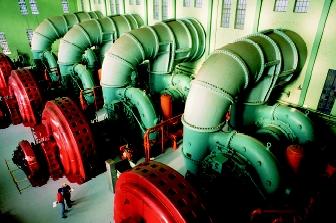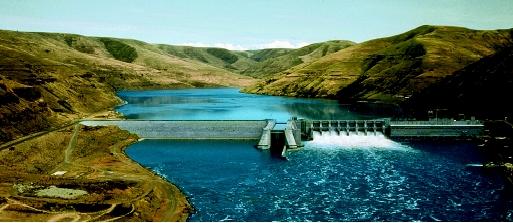Hydroelectric Power
The damming of streams and rivers has been an integral part of human civilization from its early history. Controversy paralleled this use because impounding and diverting water for upstream users affects those who live downstream, and also modifies the local habitats of plants and animals. Dams are built to control floods, improve navigation, provide a drinking-water supply, create or enhance recreational opportunties, and provide water for irrigation and other agricultural uses. A small percentage of dams (less than 3 percent in the United States) are used to generate power.
Waterpower was the impetus that powered manufacturers who were building a growing nation during the U.S. Industrial Revolution of the

Coming of Age
At the beginning of the twentieth century, hydroelectric power in the United States came of age with three events: the development of the electric generator; improvements in the hydraulic turbine; and a growing demand for electricity. The first commercial hydroelectric power plant was built in 1882 on the Fox River in Appleton, Wisconsin, in order to provide 12.5 kilowatts of power to light two paper mills and a residence. Paper manufacturer H. F. Rogers developed the plant after seeing Thomas Edison's plans for an electricity power station in New York.
Early Twentieth Century.
Commercial power companies soon began to install a large number of small hydroelectric plants in mountainous regions near metropolitan areas. By 1920, hydroelectric plants accounted for 40 percent of the electric power produced in the United States.
The creation of the Federal Power Commission in 1920 increased development of hydroelectric power plants. The development of larger and more cost-efficient power plants showed that monetary support by the federal government was necessary for such hydroelectric plants to compete effectively with other power-generating plants. Then in 1933 the government saw that besides power production, hydroelectric power plants could also be effectively used for flood control, navigation, and irrigation. As a result, the government created the Tennessee Valley Authority in the southeastern United States to develop large-scale waterpower projects. In the Pacific Northwest, the Bonneville Power Administration, created in 1937, similarly focused on electrifying farms and small communities with public power.

Today.
Hydroelectric power plants generally range in size from several hundred kilowatts to several hundred megawatts , but a few enormous plants have capacities near 10,000 megawatts in order to supply electricity to millions of people. According to the National Renewable Energy Laboratory, world hydroelectric power plants have a combined capacity of 675,000 megawatts that produces over 2.3 trillion kilowatt-hours of electricity each year; supplying 24 percent of the world's electricity to more than 1 billion customers.
In many countries, hydroelectric power provides nearly all of the electrical power. In 1998, the hydroelectric plants of Norway and the Democratic Republic of the Congo (formerly Zaire) provided 99 percent of each country's power; and hydroelectric plants in Brazil provided 91 percent of total used electricity.
In the United States, more than 2,000 hydropower plants make hydro-electric power the country's largest renewable energy source (at 49 percent). The United States increased its hydroelectric power generation from about 16 billion kilowatt-hours in 1920 to nearly 306 billion kilowatt-hours in 1999. It runs a close second to Canada in the total amount of hydroelectric power produced worldwide. However, only 8 percent of the total U.S. electrical power was generated by hydroelectric power plants in 1999.
The largest U.S. hydropower plant is the 6,800-megawatt Grand Coulee power station on the Columbia River in Washington State. Completed in 1942, the Grand Coulee today is one of the world's largest hydropower plants, behind the 13,320-megawatt Itaipu hydroelectric plant on the Paraná River between Paraguay and Brazil. *
Canada is the world's largest hydroelectric power producer. In 1999, it generated more than 340 billion kilowatt-hours of power, or 60 percent of its electric power, far outdistancing the U.S. hydropower percentage. The former Soviet Union, Brazil, China, and Norway are among the other top hydroelectric-generating countries.
Function
Hydropower functions by converting the energy in flowing water into electricity. The volume of water flow and the height (called the head) from the turbines in the power plant to the water surface created by the dam determines the quantity of electricity generated. Simply, the greater the flow and the taller the head means the more electricity produced.
The simple workings of a hydropower plant has water flowing through a dam, which turns a turbine, which then turns a generator. A hydropower plant (including a powerhouse) generally includes the following steps:
- The dam holds water back, and stores water upstream in a reservoir , or large artificial lake. The reservoir is often used for multiple purposes, such as the recreational Lake Roosevelt at the Grand Coulee Dam. Some hydroelectric dams do not impound water, but instead use the power of the flowing river, and are known as run-of-the-river.
- Gates open on the dam, allowing gravity to pull the water down through the penstock. An intake conduit carries water from the reservoir to turbines inside the powerhouse. Pressure builds up as water flows through the pipeline.
- The water then hits the large blades of the turbine , making them turn. The vertical blades are attached through a shaft to a generator located above. Each turbine can weigh as much as 172 tons and turn at a rate of 90 revolutions per minute.
- The turbine blades turn in unison with a series of magnets inside the generator. The large magnets rotate past copper coils, which produce alternating current (AC).
- The transformer inside the powerhouse takes the AC and converts it to higher-voltage current so as to allow electricity to flow to customers.
- Out of every power plant exit four power lines consisting of three wires (associated with three power phases) and a neutral (ground) wire.
- Used water is carried through outflow pipelines, which reenters the river downstream.
Impacts and Trends
Hydroelectric power is a clean source of renewable energy where an adequate water source is readily available. Hydropower plants provide inexpensive electricity without environmental pollution such as air emissions or waste byproducts. And, unlike other energy sources such as fossil fuels , water is not consumed during electrical production, but can be reused for other purposes.
However, hydropower plants that rely on impoundments can negatively affect the reservoir site and the surrounding area. New reservoirs will permanently flood valleys that may have contained towns, scenic locations, and farmland. The permanent inundation also destroys fish and wildlife habitat that once existed at the reservoir site; however, new and different habitat is created. Hydropower operations that use run-of-the-river dams can block the passage of migrating fish, such as salmon. For example, many large dams in the Columbia River Basin impede Pacific salmon during their annual migrations through the river system.
Only 2,400 of the 80,000 dams in the United States are used for hydroelectric power. It is costly to construct a new hydroelectric power plant, and construction uses much water and land. In addition, environmental concerns have been voiced against their use. According to the U.S. Geological Survey, the likely trend for the future is toward small-scale hydroelectric power plants that can generate electricity for single communities.
SEE ALSO Army Corps of Engineers, U.S. ; Bureau of Reclamation, U.S. ; Columbia River Basin ; Conflict and Water ; Dams ; Energy from the Ocean ; Geothermal Energy ; Hoover Dam ; PLANNING AND Management, History of Water Resources ; Reservoirs, Multipurpose ; Salmon Decline and Recovery ; Security and Water ; Tennessee Valley Authority .
William Arthur Atkins
Bibliography
Graham, Ian. Water Power. Austin, TX: Raintree Steck-Vaughn, 1999.
Kellert, Stephen R., ed. Macmillan Encyclopedia of the Environment, vol. 3. New York: Macmillan Library Reference USA, 1997.
Internet Resources
Hydroelectric Power Water Use. Water Science for Schools, U.S. Geological Survey. <http://ga.water.usgs.gov/edu/wuhy.html> .
International Small-Hydro Atlas. <http://www.small-hydro.com> .
* See "Bureau of Reclamation, U.S." for a photograph of Grand Coulee Dam.